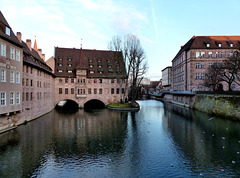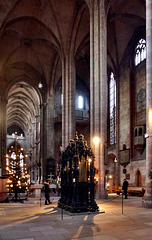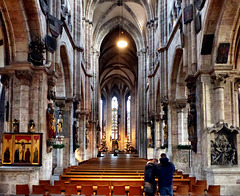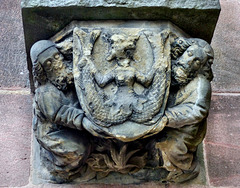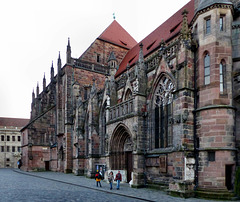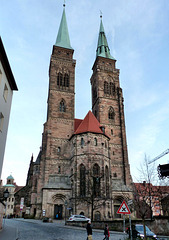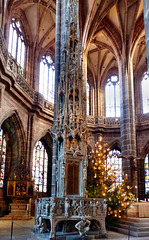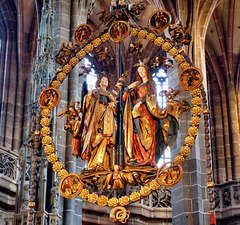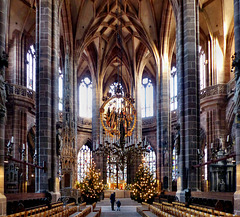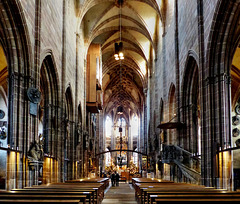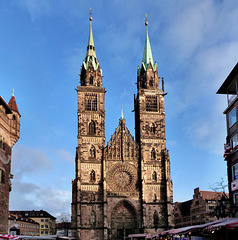Martin M. Miles' photos
Nuremberg - Heilig-Geist-Spital
| |
|
|
|
The "Heilig-Geist-Spital" (spital = hospital), caring for the sick and elderly people, was erected 1332 - 1339. It was completely funded by Konrad Groß, the probably wealthiest of the local merchants and entrepreneurs.
The hospital was built partly above the bed of the river Pegnitz in the center of the town. When carpet bombings end of World War II put the old town of Nuremberg in ruins, the hospital got nearly completely destroyed. It got reconstructed in the 1950s, only the Heilig-Geist-Kirche (church), once part of the ensemble never got rebuilt.
To the very left the facade of the "Spital Apotheke zum heiligen Geist" is partly visible.
Nuremberg - St. Sebaldus
| |
|
The construction of St. Sebaldus, named after a legendary 8th-century hermit, now the patron saint of Nuremberg, began in 1225 about two decades before the building of St. Lorenz (prev. uploads) started only about 300 meters west. That probably caused a kind of rivalry. Both churches are clearly influenced by the Bamberg Cathedral. When St. Sebaldus was completed in 1273/75 this was a Romanesque basilica.
Only decades later important changes started: the side aisles got demolished and were replaced by wider Gothic ones (1309-1345). The Gothic chancel was built (1358-1379) - and a century later the two towers were added.
When carpet bombings end of World War II destroyed the old town of Nuremberg, St. Sebaldus got seriously damaged. At that time most of the valuable interior (incl. stained glass windows) had been taken out - and so got saved. The rebuilding of the church started still in the 1940s, the (re-)consecration took place in 1957.
The shrine of Saint Sebaldus is a work of Peter Vischer the Elder (1455 - 1529) and his sons Peter and Hermann.
.
St. Sebaldus has been a Lutheran parish church since the Reformation.
www.sebalduskirche.de/
Nuremberg - St. Sebaldus
| |
|
The construction of St. Sebaldus, named after a legendary 8th-century hermit, now the patron saint of Nuremberg, began in 1225 about two decades before the building of St. Lorenz (prev. uploads) started only about 300 meters west. That probably caused a kind of rivalry. Both churches are clearly influenced by the Bamberg Cathedral. When St. Sebaldus was completed in 1273/75 this was a Romanesque basilica.
Only decades later important changes started: the side aisles got demolished and were replaced by wider Gothic ones (1309-1345). The Gothic chancel was built (1358-1379) - and a century later the two towers were added.
When carpet bombings end of World War II destroyed the old town of Nuremberg, St. Sebaldus got seriously damaged. At that time most of the valuable interior (incl. stained glass windows) had been taken out - and so got saved. The rebuilding of the church started still in the 1940s, the (re-)consecration took place in 1957.
The shrine of Saint Sebaldus.
St. Sebaldus has been a Lutheran parish church since the Reformation.
www.sebalduskirche.de/
Nuremberg - St. Sebaldus
| |
|
|
The construction of St. Sebaldus, named after a legendary 8th-century hermit, now the patron saint of Nuremberg, began in 1225 about two decades before the building of St. Lorenz (prev. uploads) started only about 300 meters west. That probably caused a kind of rivalry. Both churches are clearly influenced by the Bamberg Cathedral. When St. Sebaldus was completed in 1273/75 this was a Romanesque basilica.
Only decades later important changes started: the side aisles got demolished and were replaced by wider Gothic ones (1309-1345). The Gothic chancel was built (1358-1379) - and a century later the two towers were added.
When carpet bombings end of World War II destroyed the old town of Nuremberg, St. Sebaldus got seriously damaged. At that time most of the valuable interior (incl. stained glass windows) had been taken out - and so got saved. The rebuilding of the church started still in the 1940s, the (re-)consecration took place in 1957.
St. Sebaldus has been a Lutheran parish church since the Reformation.
www.sebalduskirche.de/
Nuremberg - St. Sebaldus
| |
|
The construction of St. Sebaldus, named after a legendary 8th-century hermit, now the patron saint of Nuremberg, began in 1225 about two decades before the building of St. Lorenz (prev. uploads) started only about 300 meters west. That probably caused a kind of rivalry. Both churches are clearly influenced by the Bamberg Cathedral. When St. Sebaldus was completed in 1273/75 this was a Romanesque basilica.
Only decades later important changes started: the side aisles got demolished and were replaced by wider Gothic ones (1309-1345). The Gothic chancel was built (1358-1379) - and a century later the two towers were added.
When carpet bombings end of World War II destroyed the old town of Nuremberg, St. Sebaldus got seriously damaged. At that time most of the valuable interior (incl. stained glass windows) had been taken out - and so got saved. The rebuilding of the church started still in the 1940s, the (re-)consecration took place in 1957.
St. Sebaldus has been a Lutheran parish church since the Reformation.
www.sebalduskirche.de/
Nuremberg - St. Sebaldus
| |
|
The construction of St. Sebaldus, named after a legendary 8th-century hermit, now the patron saint of Nuremberg, began in 1225 about two decades before the building of St. Lorenz (prev. uploads) started only about 300 meters west. That probably caused a kind of rivalry. Both churches are clearly influenced by the Bamberg Cathedral. When St. Sebaldus was completed in 1273/75 this was a Romanesque basilica.
Only decades later important changes started: the side aisles got demolished and were replaced by wider Gothic ones (1309-1345). The Gothic chancel was built (1358-1379) - and a century later the two towers were added.
When carpet bombings end of World War II destroyed the old town of Nuremberg, St. Sebaldus got seriously damaged. At that time most of the valuable interior (incl. stained glass windows) had been taken out - and so got saved. The rebuilding of the church started still in the 1940s, the (re-)consecration took place in 1957.
St. Sebaldus has been a Lutheran parish church since the Reformation.
The tympanum over the side portal depicts the Death and the "Coronation of the Virgin", a very popular icon since early Gothic times (eg. Senlis, Poitiers, Chartres..)
www.sebalduskirche.de/
Nuremberg - St. Sebaldus
| |
|
The construction of St. Sebaldus, named after a legendary 8th-century hermit, now the patron saint of Nuremberg, began in 1225 about two decades before the building of St. Lorenz (prev. uploads) started only about 300 meters west. That probably caused a kind of rivalry. Both churches are clearly influenced by the Bamberg Cathedral. When St. Sebaldus was completed in 1273/75 this was a Romanesque basilica.
Only decades later important changes started: the side aisles got demolished and were replaced by wider Gothic ones (1309-1345). The Gothic chancel was built (1358-1379) - and a century later the two towers were added.
When carpet bombings end of World War II destroyed the old town of Nuremberg, St. Sebaldus got seriously damaged. At that time most of the valuable interior (incl. stained glass windows) had been taken out - and so got saved. The rebuilding of the church started still in the 1940s, the (re-)consecration took place in 1957.
St. Sebaldus has been a Lutheran parish church since the Reformation.
www.sebalduskirche.de/
Nuremberg - St. Sebaldus
| |
|
|
|
The construction of St. Sebaldus, named after a legendary 8th-century hermit, now the patron saint of Nuremberg, began in 1225 about two decades before the building of St. Lorenz (prev. uploads) started only about 300 meters west. That probably caused a kind of rivalry. Both churches are clearly influenced by the Bamberg Cathedral. When St. Sebaldus was completed in 1273/75 this was a Romanesque basilica.
Only decades later important changes started: the side aisles got demolished and were replaced by wider Gothic ones (1309-1345). The Gothic chancel was built (1358-1379) - and a century later the two towers were added.
When carpet bombings end of World War II destroyed the old town of Nuremberg, St. Sebaldus got seriously damaged. At that time most of the valuable interior (incl. stained glass windows) had been taken out - and so got saved. The rebuilding of the church started still in the 1940s, the (re-)consecration took place in 1957.
St. Sebaldus has been a Lutheran parish church since the Reformation.
www.sebalduskirche.de/
Nuremberg - St. Lorenz
| |
|
|
|
The construction St. Lorenz started around 1250, replacing a smaller Romanesque church. At the same time St. Sebaldus, another great church in Nuremberg was under construction - only 300 meters east. That probably caused a kind of rivalry.
Nuremberg was a "Free Imperial City". The "Golden Bull" (1356) named Nuremberg as the city where newly elected kings of Germany must hold their first Imperial Diet, making Nuremberg one of the three highest cities of the Empire.
So it is no surprise, that St. Lorenz, a church that was (financially) cared of by the city council and by wealthy citizens, was a kind of very prestigious object for the city.
St. Lorenz was completed ~ 1390, but - following St. Sebaldus - already a decade later alterations started. The side aisles got demolished and were replaced by wider ones. The erection of the Gothic hall-chancel was done 1439 - 1477.
Since 1525 St. Lorenz is a (Evangelical) Lutheran parish church. Only 8 years after Martin Luther nailed his Ninety-five Theses to the door of the Schlosskirche in Wittenberg. Though Lutheran that early St. Lorenz never suffered from an iconoclast, maybe the now Lutheran citizens respected, what their ancestors had created here (by funding!).
The about 20 metres high tabernacle is a masterpiece, created by Adam Kraft (and his studio) 1493 - 1496. Donor was Hans IV. Imhoff, a wealthy, prominent merchant and city councilman. The contract between Hans IV. Imhoff and Adam Kraft is in the archives of the "Germanisches Nationalmuseum" in Nuremberg. Imhoff paid more than 77 guldens, the doors were another 20.
Three life size figures support the structure. In the center is a self portrait of Adam Kraft. He must have been a very self confident artist.
lorenzkirche.de/
Nuremberg - St. Lorenz
| |
|
The construction St. Lorenz started around 1250, replacing a smaller Romanesque church. At the same time St. Sebaldus, another great church in Nuremberg was under construction - only 300 meters east. That probably caused a kind of rivalry.
Nuremberg was a "Free Imperial City". The "Golden Bull" (1356) named Nuremberg as the city where newly elected kings of Germany must hold their first Imperial Diet, making Nuremberg one of the three highest cities of the Empire.
So it is no surprise, that St. Lorenz, a church that was (financially) cared of by the city council and by wealthy citizens, was a kind of very prestigious object for the city.
St. Lorenz was completed ~ 1390, but - following St. Sebaldus - already a decade later alterations started. The side aisles got demolished and were replaced by wider ones. The erection of the Gothic hall-chancel was done 1439 - 1477.
Since 1525 St. Lorenz is a (Evangelical) Lutheran parish church. Only 8 years after Martin Luther nailed his Ninety-five Theses to the door of the Schlosskirche in Wittenberg. Though Lutheran that early St. Lorenz never suffered from an iconoclast, maybe the now Lutheran citizens respected, what their ancestors had created here (by funding!).
The about 20 metres high tabernacle is a masterpiece, created by Adam Kraft (and his studio) 1493 - 1496. Donor was Hans IV. Imhoff, a wealthy, prominent merchant and city councilman. The contract between Hans IV. Imhoff and Adam Kraft is in the archives of the "Germanisches Nationalmuseum" in Nuremberg. Imhoff paid more than 77 guldens, the doors were another 20.
Three life size figures support the structure. In the center is a self portrait of Adam Kraft. He must have been a very self confident artist. The other figures may depict two of Kraft´s assistants.
lorenzkirche.de/
Nuremberg - St. Lorenz
| |
|
The construction St. Lorenz started around 1250, replacing a smaller Romanesque church. At the same time St. Sebaldus, another great church in Nuremberg was under construction - only 300 meters east. That probably caused a kind of rivalry.
Nuremberg was a "Free Imperial City". The "Golden Bull" (1356) named Nuremberg as the city where newly elected kings of Germany must hold their first Imperial Diet, making Nuremberg one of the three highest cities of the Empire.
So it is no surprise, that St. Lorenz, a church that was (financially) cared of by the city council and by wealthy citizens, was a kind of very prestigious object for the city.
St. Lorenz was completed ~ 1390, but - following St. Sebaldus - already a decade later alterations started. The side aisles got demolished and were replaced by wider ones. The erection of the Gothic hall-chancel was done 1439 - 1477.
Since 1525 St. Lorenz is a (Evangelical) Lutheran parish church. Only 8 years after Martin Luther nailed his Ninety-five Theses to the door of the Schlosskirche in Wittenberg. Though Lutheran that early St. Lorenz never suffered from an iconoclast, maybe the now Lutheran citizens respected, what their ancestors had created here (by funding!).
The "Engelsgruss" (= "Ave Maria") carved by Veit Stoss ~
1517.
Luke 1:26-28
"In the sixth month of Elizabeth’s pregnancy, God sent the angel Gabriel to Nazareth, a town in Galilee, to a virgin pledged to be married to a man named Joseph, a descendant of David. The virgin’s name was Mary. The angel went to her and said, "Greetings, you who are highly favored! The Lord is with you.""
lorenzkirche.de/
Nuremberg - St. Lorenz
| |
|
The construction St. Lorenz started around 1250, replacing a smaller Romanesque church. At the same time St. Sebaldus, another great church in Nuremberg was under construction - only 300 meters east. That probably caused a kind of rivalry.
Nuremberg was a "Free Imperial City". The "Golden Bull" (1356) named Nuremberg as the city where newly elected kings of Germany must hold their first Imperial Diet, making Nuremberg one of the three highest cities of the Empire.
So it is no surprise, that St. Lorenz, a church that was (financially) cared of by the city council and by wealthy citizens, was a kind of very prestigious object for the city.
St. Lorenz was completed ~ 1390, but - following St. Sebaldus - already a decade later alterations started. The side aisles got demolished and were replaced by wider ones. The erection of the Gothic hall-chancel was done 1439 - 1477.
Since 1525 St. Lorenz is a (Evangelical) Lutheran parish church. Only 8 years after Martin Luther nailed his Ninety-five Theses to the door of the Schlosskirche in Wittenberg. Though Lutheran that early St. Lorenz never suffered from an iconoclast, maybe the now Lutheran citizens respected, what their ancestors had created here (by funding!).
The large round "Engelsgruss" (= "Ave Maria") carved by Veit Stoss and the vaults of the the hall chancel above.
When carpet bombings during World War II destroyed most of the old town of Nuremberg, St. Lorenz got badly damaged. The rebuilding started end of the 1940s.
lorenzkirche.de/
Nuremberg - St. Lorenz
| |
|
|
|
The construction St. Lorenz started around 1250, replacing a smaller Romanesque church. At the same time St. Sebaldus, another great church in Nuremberg was under construction - only 300 meters east. That probably caused a kind of rivalry.
Nuremberg was a "Free Imperial City". The "Golden Bull" (1356) named Nuremberg as the city where newly elected kings of Germany must hold their first Imperial Diet, making Nuremberg one of the three highest cities of the Empire.
So it is no surprise, that St. Lorenz, a church that was (financially) cared of by the city council and by wealthy citizens, was a kind of very prestigious object for the city.
St. Lorenz was completed ~ 1390, but - following St. Sebaldus - already a decade later alterations started. The side aisles got demolished and were replaced by wider ones. The erection of the Gothic hall-chancel was done 1439 - 1477.
Since 1525 St. Lorenz is a (Evangelical) Lutheran parish church. Only 8 years after Martin Luther nailed his Ninety-five Theses to the door of the Schlosskirche in Wittenberg. Though Lutheran that early St. Lorenz never suffered from an iconoclast, maybe the now Lutheran citizens respected, what their ancestors had created here (by funding!).
The large round "Engelsgruss" (= "Ave Maria") carved by Veit Stoss is in the center of the hall chancel. Seen to the left the (nearly 20 meters high!) tabernacle by Adam Kraft.
When carpet bombings during World War II destroyed most of the old town of Nuremberg, St. Lorenz got badly damaged. The rebuilding started end of the 1940s.
lorenzkirche.de/
Nuremberg - St. Lorenz
| |
|
The construction St. Lorenz started around 1250, replacing a smaller Romanesque church. At the same time St. Sebaldus, another great church in Nuremberg was under construction - only 300 meters east. That probably caused a kind of rivalry.
Nuremberg was a "Free Imperial City". The "Golden Bull" (1356) named Nuremberg as the city where newly elected kings of Germany must hold their first Imperial Diet, making Nuremberg one of the three highest cities of the Empire.
So it is no surprise, that St. Lorenz, a church that was (financially) cared of by the city council and by wealthy citizens, was a kind of very prestigious object for the city.
St. Lorenz was completed ~ 1390, but - following St. Sebaldus - already a decade later alterations started. The side aisles got demolished and were replaced by wider ones. The erection of the Gothic hall-chancel was done 1439 - 1477.
Since 1525 St. Lorenz is a (Evangelical) Lutheran parish church. Only 8 years after Martin Luther nailed his Ninety-five Theses to the door of the Schlosskirche in Wittenberg. Though Lutheran that early St. Lorenz never suffered from an iconoclast, maybe the now Lutheran citizens respected, what their ancestors had created here (by funding!)
When carpet bombings during World War II destroyed most of the old town of Nuremberg, St. Lorenz got badly damaged. The rebuilding started end of the 1940s.
The nave.
lorenzkirche.de/
Nuremberg - St. Lorenz
| |
|
The construction St. Lorenz started around 1250, replacing a smaller Romanesque church. At the same time St. Sebaldus, another great church in Nuremberg was under construction - only 300 meters east. That probably caused a kind of rivalry.
Nuremberg was a "Free Imperial City". The "Golden Bull" (1356) named Nuremberg as the city where newly elected kings of Germany must hold their first Imperial Diet, making Nuremberg one of the three highest cities of the Empire.
So it is no surprise, that St. Lorenz, a church that was (financially) cared of by the city council and by wealthy citizens, was a kind of very prestigious object for the city.
St. Lorenz was completed ~ 1390, but - following St. Sebaldus - already a decade later alterations started. The side aisles got demolished and were replaced by wider ones. The erection of the Gothic hall-chancel was done 1439 - 1477.
Since 1525 St. Lorenz is a (Evangelical) Lutheran parish church. Only 8 years after Martin Luther nailed his Ninety-five Theses to the door of the Schlosskirche in Wittenberg.
When carpet bombings during World War II destroyed most of the old town of Nuremberg, St. Lorenz got badly damaged. The rebuilding started end of the 1940s.
Jamb statues flank the main portal.
lorenzkirche.de/
Nuremberg - St. Lorenz
| |
|
|
|
The construction St. Lorenz started around 1250, replacing a smaller Romanesque church here. At the same time St. Sebaldus, another great church in Nuremberg was under construction - only 300 meters east. That probably caused a kind of rivalry.
St. Lorenz was completed ~ 1390, but - following St. Sebaldus - already a decade later alterations started. The side aisles got demolished and were replaced by wider ones. The erection of the Gothic hall-chancel was done 1439 - 1477. Since 1525 St. Lorenz is a (Evangelical) Lutheran parish church. Only 8 years after Martin Luther nailed his Ninety-five Theses to the door of the Schlosskirche in Wittenberg.
When carpet bombings during World War II destroyed most of the old town of Nuremberg, St. Lorenz got badly damaged. The rebuilding started end of the 1940s.
The rose window of the western facade is 9 meters in diameter.
lorenzkirche.de/
Nuremberg - St. Lorenz
| |
|
|
|
The construction St. Lorenz started around 1250, replacing a smaller Romanesque church here. At the same time St. Sebaldus, another great church in Nuremberg was under construction - only 300 meters east. That probably caused a kind of rivalry.
St. Lorenz was completed ~ 1390, but - following St. Sebaldus - already a decade later alterations started. The side aisles got demolished and were replaced by wider ones. The erection of the Gothic hall-chancel was done 1439 - 1477. Since 1525 St. Lorenz is a (Evangelical) Lutheran parish church. Only 8 years after Martin Luther nailed his Ninety-five Theses to the door of the Schlosskirche in Wittenberg.
When carpet bombings during World War II destroyed most of the old town of Nuremberg, St. Lorenz got badly damaged. The rebuilding started end of the 1940s.
lorenzkirche.de
Cologne - Ludari
| |
|
|
Cologne, the fourth-largest city in Germany, has all kinds and styles of restaurants and eateries.
Ludari offers best Italian food in the vibrant "Suedstadt" quarter - and over noontime tasty pasta dishes are served here.
Mille grazie, Ciro!
www.youtube.com/watch?time_continue=164&v=oyrbH3OoLdc
-
Spaghetti Frutti di Mare
Jump to top
- ipernity © 2007-2024
- Help & Contact
|
Club news
|
About ipernity
|
History |
ipernity Club & Prices |
Guide of good conduct
Donate | Group guidelines | Privacy policy | Terms of use | Statutes | In memoria -
Facebook
Twitter

